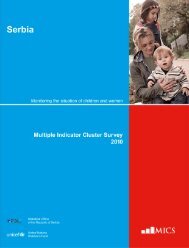Kosovo non-majority communities within the primary and ... - OSCE
Kosovo non-majority communities within the primary and ... - OSCE
Kosovo non-majority communities within the primary and ... - OSCE
Create successful ePaper yourself
Turn your PDF publications into a flip-book with our unique Google optimized e-Paper software.
did not end with <strong>the</strong> dissolution of <strong>the</strong> Ottoman empire but continued with <strong>Kosovo</strong>’s “forced”inclusion into Serbia. 80 <strong>Kosovo</strong> Serb eight graders are taught that most Albanians keep cattle<strong>and</strong> live in rural villages, <strong>and</strong> that during World War II <strong>Kosovo</strong> was part of a GreaterAlbania, under which time a great number of <strong>Kosovo</strong> Serbs were killed or deported in aneffort to ethnically cleanse <strong>Kosovo</strong>. 81 On <strong>the</strong> whole, Serbian history school books steer clearof contemporary Balkan history. 82 <strong>Kosovo</strong> Albanian school books do discuss contemporaryhistory. 83 <strong>Kosovo</strong> Albanian elementary school children are taught, for example, that <strong>the</strong>Serbian military <strong>and</strong> police massacred <strong>Kosovo</strong> Albanians in 1998-1999. 84 Two pages arespent on <strong>the</strong> <strong>Kosovo</strong> Liberation Army Comm<strong>and</strong>er Adem Jashari alone.Serbian-curriculum schoolsThe Serbian curriculum for <strong>primary</strong> education (grades 1-4) includes 20 classes a week ofwhich 9 are devoted to <strong>the</strong> study of <strong>the</strong> Serbian language, literature, art, music <strong>and</strong> religion.The teaching of history is introduced in <strong>the</strong> grade 5. The number of teaching hours increasesfrom 27 to 30 in <strong>the</strong> grades 5-8 <strong>and</strong> approximately one third of <strong>the</strong> classes (or 10 hours)remains devoted to community-specific “national” subjects. This curriculum is appliedSerbia-wide, with no special reference to <strong>Kosovo</strong> Serbs. Textbooks do not present a historyof <strong>Kosovo</strong>, but ra<strong>the</strong>r of <strong>the</strong> Serbian nation as a whole, <strong>and</strong> stay clear of contemporaryhistory (period from 1998 to present) or cover it only through a general presentation of facts<strong>and</strong> dates lacking analysis. <strong>Kosovo</strong> Serb students learn mainly about Albanians <strong>and</strong> <strong>the</strong>irhistory from World War II onward. As for geography, children are taught that <strong>Kosovo</strong> is <strong>the</strong>sou<strong>the</strong>rn province of Serbia where most of <strong>the</strong> Albanian minority lives. 85places throughout <strong>Kosovo</strong> <strong>and</strong> <strong>the</strong> Dibra province” Fehmi Rexhepi & Frasher Demaj 2005, Historia 8 shkollae mesme e ulet, Shtepia Botuese "Libri Shkollor" Prishtinë/Priština, page 105. See also pages 68, 78 & 104-111.80 Later incorporated in 1918 into <strong>the</strong> Kingdom of Serbs, Croats <strong>and</strong> Slovenes.81 Suzana Rajić, Kosta Nikolić & Nebojša Jovanović, 2005, Istorija 8: Za 8 Razred Osnovne Škole, Stampa“Kultura” Baćki Petrovac, p. 27 & 134-5.82 In a sample of history books from fifth <strong>and</strong> eight grades, <strong>the</strong>re is, for instance, no reference to <strong>the</strong> <strong>Kosovo</strong>conflict of 1998-1999. The Milosević era is roughly described as a period in which relations with o<strong>the</strong>rrepublics of <strong>the</strong> former Yugoslavia took a turn for <strong>the</strong> worse.83 In accordance with <strong>Kosovo</strong> Albanian history books from grades 6-9.84 “In <strong>the</strong>se conditions Serbian occupiers initiated <strong>the</strong>ir military <strong>and</strong> police propag<strong>and</strong>a machinery not justagainst KLA (<strong>Kosovo</strong> Liberation Army) but also against <strong>the</strong> civilian population, result of which wereunbelievable scenes of barbarianism, killings <strong>and</strong> massacres of innocent people (children, women <strong>and</strong>elderly), burning of <strong>the</strong> houses <strong>and</strong> massive imprisonment of youngsters etc. The biggest massacres wereundertaken during February <strong>and</strong> March 1998 especially in <strong>the</strong> Drenicë/Drenica region. Such massacres onAlbanian civil population were done during <strong>the</strong> entire year 1998 throughout <strong>Kosovo</strong>.” Source: FehmiRexhepi, 2006, Historia 9, Libri Shkollor, Prishtinë/Priština, p. 168. The Drenicë/Drenica region comprises<strong>the</strong> Skenderaj/Srbica, Glogoc/Glogovac <strong>and</strong> Malishevë/Mališevo municipalities, as well as <strong>the</strong> South westernpart of Mitrovicë/Mitrovica region. The Bosnian language version of “Man <strong>and</strong> Nature”, reads: “Serbianpower, despite many attempts did not manage to change <strong>the</strong> ethnic structure of <strong>the</strong> inhabitants in my country.The peak of madness of <strong>the</strong>se barbarians was achieved between 24 March <strong>and</strong> 12 June.” Source: RasimBejtullahu, Muhamet Bicaj, Ragip Rrustemi, “Man <strong>and</strong> Nature”, 3 rd grade of <strong>primary</strong> school, Libri Shkollor,Prishtinë/Priština 2007, p. 67.85 Consultation of textbooks <strong>and</strong> discussion with <strong>Kosovo</strong> Serb students in Štrpce/Shtërpcë, Viti/Vitina,Gjilan/Gnjilane, Novobërdë/Novo Brdo, <strong>and</strong> Kamenicë/Kamenica. See also Rada Sitarica & Milutin Tadić,2008, Geography for Sixth Grade of Primary School, Institute for Texbooks, Belgrade, pp. 90-91 where <strong>the</strong>2002 statistical data for Serbia also include <strong>Kosovo</strong> <strong>and</strong> Metohija: “number of inhabitants: 9,396,000 (<strong>the</strong>2001 estimate for <strong>Kosovo</strong> <strong>and</strong> Metohija is 1,900,000 inhabitants)” <strong>and</strong> where <strong>the</strong> maps of Serbia displayed atpages 90 <strong>and</strong> 91 also include <strong>Kosovo</strong>. Rada Sitarica & Milutin Tadić, 2008, Geography Workbook for SixthGrade of Primary School, Institute for Texbooks, Belgrade, p. 66 (where <strong>the</strong> territory of Serbia is describedas comprising Central Serbia, Vojvodina, <strong>and</strong> <strong>Kosovo</strong> <strong>and</strong> Metohija) <strong>and</strong> p. 63 (where <strong>the</strong> cardinal points of19
















